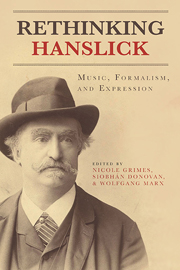Book contents
- Frontmatter
- Contents
- Foreword by Mark Evan Bonds
- Acknowledgments
- Abbreviations
- Chronology
- Introduction
- Part One Rules of Engagement
- 1 Negotiating the “Absolute”: Hanslick's Path through Musical History
- 2 Hanslick's Composers
- 3 Hanslick, Legal Processes, and Scientific Methodologies: How Not to Construct an Ontology of Music
- 4 Otakar Hostinský, the Beautiful, and the Gesamtkunstwerk
- Part Two Liberalism and Societal Order
- Part Three Memoirs and Meaning in Social Contexts
- Part Four Critical Battlefields
- Selected Bibliography
- List of Contributors
- Index
2 - Hanslick's Composers
from Part One - Rules of Engagement
Published online by Cambridge University Press: 05 July 2013
- Frontmatter
- Contents
- Foreword by Mark Evan Bonds
- Acknowledgments
- Abbreviations
- Chronology
- Introduction
- Part One Rules of Engagement
- 1 Negotiating the “Absolute”: Hanslick's Path through Musical History
- 2 Hanslick's Composers
- 3 Hanslick, Legal Processes, and Scientific Methodologies: How Not to Construct an Ontology of Music
- 4 Otakar Hostinský, the Beautiful, and the Gesamtkunstwerk
- Part Two Liberalism and Societal Order
- Part Three Memoirs and Meaning in Social Contexts
- Part Four Critical Battlefields
- Selected Bibliography
- List of Contributors
- Index
Summary
Readers usually interpret Eduard Hanslick's famous treatise On the Musically Beautiful in light of its memorable statements and arguments that articulate a “formalist” position, that is, an account of self-sufficient musical art, purely musical beauty, and an appropriate contemplative mode of listening. In this standard interpretation, Hanslick's treatise remains, to the present, the most prominent example of formalism in musical aesthetics.
However, Hanslick's detailed music criticism, addressing specific compositions in the context of Viennese concert life, does not typically stay within the limits of this aesthetic position. The apparent discrepancy between Hanslick's treatise—a brief, early text—and the other writings that took up much of his life is well-known. Even more interestingly, Hanslick's treatise itself offers heterogeneous statements and implications about music and music perception.
In this paper, I indicate the complex, unresolved character of Hanslick's thought, especially in the treatise, with regard to a particular topic, the role of the composer in musical experience. This emphasis departs from the more usual focus on ideas about emotion and expression. I shall be pointing to some confusion in Hanslick's thinking; however, I regard this confusion as evidence of a praiseworthy, if not fully self-aware, openness to musical experience.
- Type
- Chapter
- Information
- Rethinking HanslickMusic, Formalism, and Expression, pp. 38 - 51Publisher: Boydell & BrewerPrint publication year: 2013

